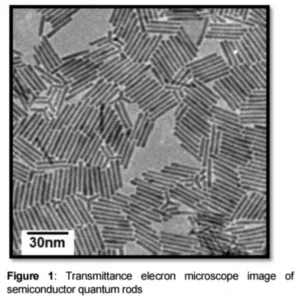Over this year, we’ve covered Quantum Dots a lot, and we’ve mentioned Quantum Rods (QRs) – but what is the interest in rods if dots have such advantages? Well, back in 2015, Merck acquired Qlight Nanotech of Israel which had been working on the technology. Merck knows a lot about the display business, and doesn’t ‘splash its cash’, so anything it spends money on is probably interesting!
From a paper presented by QLight at Display Week 2015The key difference between quantum dots and quantum rods is, of course, the shape. Rods, like liquid crystal (LC) molecules, are extended in length (relatively!) rather than being spherical, although they can be made in other shapes, including star shapes, according to Merck. The shape of the materials mean that the crystals are ‘anisotropic’ which means, again like liquid crystal materials, that the effect that they have on light is different in different directions – the property that allows liquid crystal displays to work.
QRs are seen in nature and it turns out that the light produced by fireflies comes from nanorods.
The difference between quantum rods and LC materials is that quantum rods are emissive. The advantage of the rod structure, rather than dots, is that light emitted by quantum rods is polarised, whereas in quantum dots, it’s not polarised (which means the polariser has to be moved in the LCD structure if you are adopting ‘QD filters’ – see Chris’s recent Display Daily Nanosys to Show Color Volume Demo at CES 2017).
Now, if you are making an LCD with QDs in the backlight, the light has to be passed through a polariser in order to make the LCD work. Without recycling, this is inefficient, with light wasted. Re-cycling the otherwise wasted light that is not correctly polarised is possible, but it costs money. How much better would it be if the light coming from the backlight was already polarised? That’s one of the attractions of quantum rods. If the rods can be aligned in manufacture, then the light emitted is already polarised.
In a paper published at Display Week, Merck explained that it had created an electrospun nanofibre sheet embedded with quantum rods. It was tricky to create the sheet, with reliable alignment, but there was a good effect on the polarisation. Different fabrication techniques tried by the group lead to different levels of alignment and that was reflected in different degrees of polarisation.
Merck also tried making nanofibre sheets that were much less aligned than the very polarised versions. In this case, the firm found that the light coming out of the Quantum Rods is emitted more efficiently than with QDs, as less of the light is lost by internal reflection within the sheet. Effectively, less of the light was lost because it is more directional.

I made the suggestion, after hearing about the development of air-processable QDs, that I couldn’t see any reason why OLED makers shouldn’t use QDs to avoid the problems of patterning RGB OLEDs. I wondered if using a simple blue OLED and then putting the QDs where the filter would be in a WOLED might be a good way to make a TV OLED?
It turns out that Merck has been working on this idea using QRs. Merck made a sheet of green and red pixels, using QRs, and used a blue LED of 470nm to stimulate it – and to provide the blue through transparent pixels. Using this technique, Merck was able to make a wide colour gamut of 80% of the area of Rec 2020, although only 70% of the actual area of the 2020 gamut was covered as the primaries were not optimised.
At the moment, QDs are more developed than QDs, but it looks as though QRs will also be a phrase that we will see a lot more of, over the next couple of years. – Bob Raikes
(I had fun looking at Google with the search term Quantum Rods. It turns out that there is a brand of fishing rods called Quantum – it may sell more of its equipment into the technology community in the future!)

